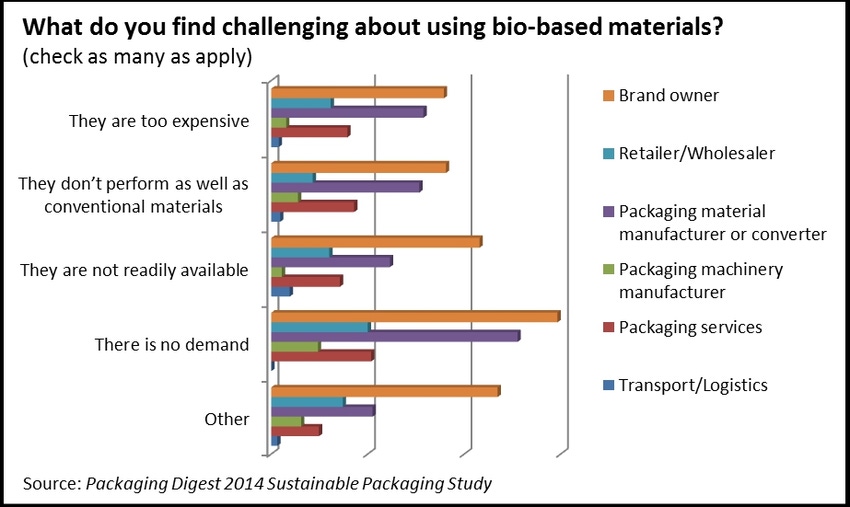January 16, 2015

Things would be different if we all thought about packaging sustainability the same way. That’s what you, the Packaging Digest readers, told us when we asked what stands in the way of making packaging more sustainable. More than the challenges of inadequate recycling and composting infrastructure, more than your inability to charge a premium for more sustainable packaging options, the enemy number one is the lack of a common understanding of what exactly “sustainable packaging” means.
Looking at the rest of the results from our 2014 joint sustainable packaging survey with Packaging Digest, it’s hard to disagree. The conversation to develop and further the concept of sustainable packaging may be at least a decade old, but it’s clear that it has not yet evolved to the point where a standard understanding exists.
The first piece of evidence shows up when we asked about your sustainable packaging goals. There is some supply-chain consensus. For example, everyone agrees that lowering costs is the No.1 sustainable packaging goal, underscoring the importance of aligning sustainability initiatives with economic gains.
Beyond this longtime stalwart of packaging pursuits, however, there is little agreement. On the upstream end, material manufacturers and converters seek to continue lightweighting while also driving down in-house waste (both of which tend to be accompanied by appreciable cost savings), but on the downstream end of the supply chain we see that the No.2 goal of retailers is increasing recyclability, something that resonates well with consumers.
There is more evidence of this difference in priorities elsewhere in the survey results. The overwhelming majority of material manufacturers and converters say their efforts are focused on the full life cycle of a package, but brands (54%) and especially retailers (60%) indicated that their primary focus in on end-of-life issues.
That disconnect may be explained by differing business motives…but another imbalance in the survey results suggests a different kind of disconnect. Converters indicate that they are working to increase the availability of bio-based materials, but the results show that brands aren’t setting goals to increase their usage of those materials. Only 14% of responding brand owners said they have a current goal around using bio-based materials, while 38% of material manufacturers and converters have goals around supplying more of these materials to the marketplace. This could be evidence of an upstream technology push preceding a corresponding downstream pull.
Even though the brand owners surveyed didn’t tend to have current goals around using bio-based materials, a remarkable 42% say they have plans to use bio-based materials in the next three to five years.
A suggestion of today’s barrier comes in the form of a rare display of unity from almost every supply chain position: The survey results show that manufacturers, converters and brand owners all agree that cost is currently the biggest challenge to using bio-based materials.
Results from these kinds of surveys never illuminate the entire story, but the evidence is clear that our opinions differ greatly on what is most important when it comes to sustainable packaging.
As a consequence, sustainable packaging goals are rarely harmonized and efforts to make packaging more sustainable are disparate and, occasionally, at odds with each other. It’s something we’re working on with SPC members in our efforts to alleviate the “survey fatigue” experienced by suppliers that are asked to report on a multitude of sustainability qualities in so many different ways.
Still, a positive message can be found in this lack of a common understanding. The packaging community is casting a broad net trying to capture opportunities for sustainability. By approaching the philosophy of sustainability from so many angles, no stone is left unturned. The last thing our industry could be accused of is having too narrow a focus on sustainable packaging.
Author Adam Gendell is a project manager at GreenBlue’s Sustainable Packaging Coalition and is responsible for orchestrating its fall conference, SPC Advance. For more information about the SPC, visit www.sustainablepackaging.org.
About the Author(s)
You May Also Like




